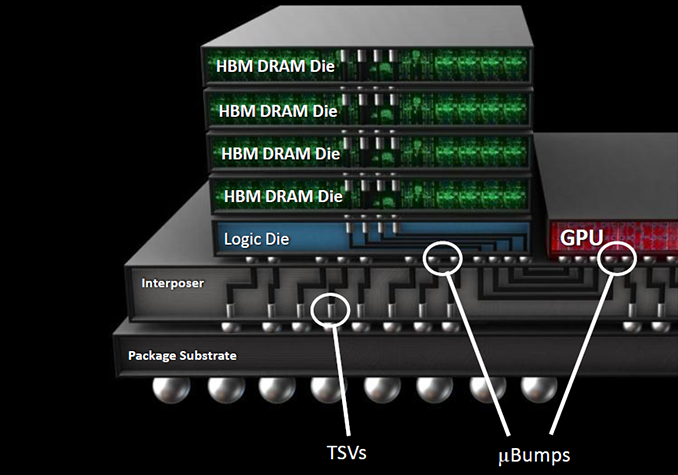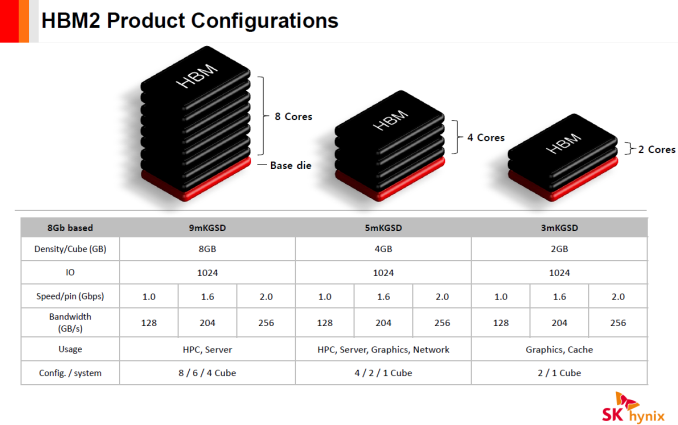SK Hynix: Customers Willing to Pay 2.5 Times More for HBM2 Memory
by Anton Shilov on August 4, 2017 9:00 AM EST
SK Hynix was the first DRAM manufacturer to start producing HBM Gen 1 memory in high volume back in 2015. However, the company is somewhat behind its rival Samsung when it comes to HBM Gen 2 memory. At present, SK Hynix is gearing up to start volume production of HBM2, and the first commercial chips are due only now, in this latter half of the year. To that end, an interesting point was made by an executive of SK Hynix during a recent conference call: the company’s customers are willing to pay up to 2.5 times more for HBM2 versus what they paid for HBM1.
As a bit of background, SK Hynix formally announced their intention to produce GDDR6 in late April, and subsequently added 8 Gb chips rated for 12 and 14 Gbps data rates at 1.35 V to its databook. Meanwhile, 4Hi HBM2 chips with 4 GB capacity have existed in SK Hynix’s product catalog for some time, but recently the company reduced their data rate to 1.6 Gbps.
At present, SK Hynix is working with a number of partners to bring their GDDR6 and HBM2 memory chips to the market. While SK Hynix is not disclosing the names of its partners, it's reasonable to assume that the two major GPU developers are among them, as they're the biggest customers for both memory types at this moment. Meanwhile, the company claims that both GDDR6 and HBM2 will be more expensive than GDDR5, which shouldn't come as a surprise since GDDR5 has been on the market for many years now, meaning its costs are relatively low when compared to new types of memory. This may in turn have an impact on video card pricing, though with AMD and NVIDIA already tapping HBM2 and GDDR5X respectively for current generation products, both companies are already very familiar with the costs of high-end memory technologies.
Getting back to the subject at hand then, HBM2 memory from SK Hynix will be substantially different from HBM1 DRAM not only in terms of performance, but also in terms of per-chip capacity, which makes them more difficult and expensive to produce. As a result, the manufacturer will have all the reason to charge more for such DRAM ICs. According to the aforementioned SK Hynix executive, customers are “willing to pay at least double” or even 2.5 times more for HBM2 memory compared to HBM1 DRAM. Considering that HBM2 memory is used for high-end compute cards such as NVIDIA's Tesla P100, the forthcoming Tesla V100, and AMD's various Vega products, it is not surprising that customers are willing to pay extra for memory for their high-end, high-priced products.
One of the key takeaways from this, besides the expected higher prices of GDDR6 and HBM2 memory from SK Hynix, is the fact that this confirms that the company has not started mass production of HBM2 quite yet. For the time being then, this leaves Samsung as the only HBM2 manufacturer shipping in volume, which means I wouldn't be surprised if we see the company's 4-Hi HBM2 stacks show up on AMD's forthcoming HBM2-based RX Vega video cards.
Related Reading:
Source: SK Hynix











22 Comments
View All Comments
ToTTenTranz - Friday, August 4, 2017 - link
What does "charging more" actually mean?It's charging more per-GB? More per-stack at same stack height?
If it's 2.5x more for a HBM2 4-Hi stack than a HBM1 4-Hi stack, is it really an unpredictable premium? The first offers 4x more memory at 2x the bandwidth of the second.
Nowadays a mid-range GPU could use a single HBM2 stack for 4GB at 256GB/s, whereas back in 2015 a single stack of HBM1 with 1GB @ 128GB/s wouldn't do that much good to anything.
As for SK Hynix still not mass-producing HBM2, I wonder if this isn't the main reason for Vega's apparent delay (e.g. in late 2016 although they were using risk-production SKHynix stacks for Vega demos, they had to shift all their orders to Samsung for volume production of the graphics card).
Flunk - Friday, August 4, 2017 - link
Vega is about a year late at this point and low production of HBM2 overall is definitely the main reason. The only reason they can launch now is that Samsung finally has enough production for it. I'm not sure Hynix is the reason, just overall lack of available HBM2 and the subsequent high cost of it.Azix - Friday, August 4, 2017 - link
why do people keep saying this foolishness? vega was shown as earliest 2017 january. Prob first half 2017. yet people keep claiming over a year lategruffi - Saturday, August 5, 2017 - link
Vega isn't about a year late. It's about a half year late.StevoLincolnite - Sunday, August 6, 2017 - link
It's not even half a year late.Middle of the year is when we typically see AMD releases.
Fury dropped in July 2015, Polaris arrived mid 2016 as well.
However... AMD *needed* Vega a year ago to do battle with Pascal, that is the difference.
Veradun - Friday, August 4, 2017 - link
I agree with you, we need more infos to understand thisddriver - Friday, August 4, 2017 - link
Poor AMD and their margins on vega... HBM2 was a bad idea, for a company that is in a very difficult financial situation to be an early adopter for something that is expensive, even more so amplified by the insufficient supply.It was understandable for nvidia, as they put it into very expensive products with crazy margins, but vega ain't gonna be that. Whatever savings in power it may deliver, the heavy delay and rather low expectations for performance considering the transistor and power budget, vega will have to sell at a rather low price, which doesn't stack well with expensive memory.
Anonymous Blowhard - Friday, August 4, 2017 - link
Given how well Vega allegedly mines cryptocurrency, I imagine AMD could price them in terms of "organs necessary to sell" and still move units.crazylocha - Friday, August 4, 2017 - link
Still begs an answer to a very hot question.RUMOR that Vega is incredible at mining, and have yet to hear anything on Titan XP's recent tripling of abilities in data from recent huge Nvidia driver release and whether or not that has ANY effect on mining with Titan series.
Strangely quiet. Not even denials or only 5% or 10% and still not worth going that high green route.
Has anyone seen or heard otherwise?
lefty2 - Friday, August 4, 2017 - link
Even if crytocurrency didn't exist, AMD would have trouble making enough to meet demand. Vega is extremely good at professional workloads (coming close to the Quadro P6000).The truth is really demand for high end GPUs is hugh and benefits both companies.